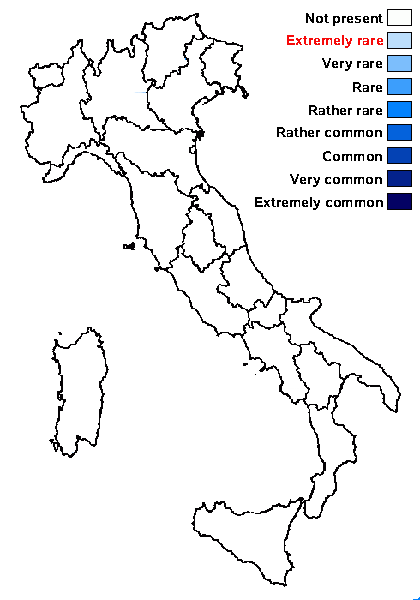Anema nodulosum (Nyl.) Forssell
Nova Acta R. Soc. Scient. Upsal., Ser. 3, 13, 6: 93, 1885. Basionym: Collema nodulosum Nyl. - Act. Soc. Linn. Bordeaux, 21, 4: 266, 1857 (1856)
Synonyms:
Distribution:
Description: Thallus squamulose, homoiomerous, slightly gelatinous when wet, in section with a loosely reticulate network of thin hyphae enclosing groups of cyanobacterial cells. Squamules erect, peltate, brown-black to black but densely bluish-pruinose, 1-2 mm high, 0.3-0.5 mm wide in apical parts, attached by a holdfast of rhizohyphae, densely crowded into a 4(-5) mm wide, fissurate pillow with weakly lobulate margins. Apothecia pycnoascocarps, 1 per squamule, immersed in the thallus, 0.25-0.4(-0.5) mm across, with a dark reddish brown, initially urceolate then flat disc, and a thin, rugose thalline margin. Proper exciple poorly developed; epithecium orange-brown, 5-10 µm high; hymenium colourless, 70-120 µm high, the hymenial gel I+ blue; paraphyses mostly simple, moniliform in upper part, capitate; hypothecium yellowish, up to 150 µm high in central part. Asci 8-spored, broadly clavate, thin-walled, with a distinct amyloid outer cap, but no apical dome, Peccania-type. Ascospores 1-celled, hyaline broadly ellipsoid or subglobose, 9-15 x 6-9 µm, the wall 1-2 µm thick. Pycnidia globose, mostly terminal, 90-120 µm wide, immersed, unilocular. Conidia ellipsoid, 1.5-4 x 1-1.5 µm. Photobiont cyanobacterial, chroococcoid, of a few, 8-15 µm wide cells often penetrated by haustoria and surrounded by a gelatinous sheath which is colourless in inner parts, yellowish brown near the thallus surface. Spot tests: all negative. Chemistry: without lichen substances.Note: a species which is apparently not rare in SE Spain, Algeria and Morocco, also known from Iran and North America, found on steeply inclined, sunny surfaces of calcareous or basic siliceous rocks with periodical water seepage after rain; to be looked for in Mediterranean Italy.
Growth form: Squamulose
Substrata: rocks
Photobiont: cyanobacteria, coccaceous (e.g. Gloeocapsa)
Reproductive strategy: mainly sexual
On otherwise dry surfaces with short periods of water seepage after rain

Predictive model
Growth form: Squamulose
Substrata: rocks
Photobiont: cyanobacteria, coccaceous (e.g. Gloeocapsa)
Reproductive strategy: mainly sexual
On otherwise dry surfaces with short periods of water seepage after rain

Predictive model
 Index Fungorum
Index Fungorum
 GBIF
GBIF



